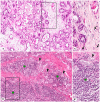Tumor Infiltrating Lymphocytes in Pet Rabbit Mammary Carcinomas: A Study with Relevance to Comparative Pathology
- PMID: 32824521
- PMCID: PMC7459912
- DOI: 10.3390/ani10081437
Tumor Infiltrating Lymphocytes in Pet Rabbit Mammary Carcinomas: A Study with Relevance to Comparative Pathology
Abstract
Tumor infiltrating lymphocytes (TILs) serve as prognostic biomarker in human breast cancer. Rabbits have the potential to act as animal model for human breast cancer, and close similarities exist between the rabbit and human immune system. The aim of this study is to characterize TILs in pet rabbit mammary carcinomas and to statistically correlate results with histological and immunohistochemical tumor characteristics. Microscopic evaluation of TILs was performed in hematoxylin and eosin stained sections of 107 rabbit mammary carcinomas according to international guidelines for human breast cancer. Data on histological features of malignancy, estrogen and progesterone receptor status and calponin expression were obtained from the data base. This study revealed a statistical association between stromal TILs in the central tumor (CT) and infiltrative margin. Higher maximal percentages of stromal TILs at the CT were statistically correlated with decreased mitotic count and lower tumor grade. An increased number of calponin positive tumor cells was statistically associated with a lower mitotic count and a higher percentage of stromal TILs. Results suggest that higher percentages of stromal TILs are useful biomarkers that may point toward a favorable prognosis in rabbit mammary carcinomas and support the concept of the use of rabbits for translational research.
Keywords: Oryctolagus cuniculus; animal model; biomarker; breast cancer; comparative pathology; light microscopy; mammary carcinomas; pet rabbit; translational medicine; tumor infiltrating lymphocytes.
Conflict of interest statement
The authors declare no conflict of interest.
Figures







References
-
- Mage R.G. Immunology of lagomorphs, Chapter IV. In: Pastoret P.-P., Griebel P., Bazin H., Govaerts A., editors. Handbook of Vertebrate Immunology. Academic Press; San Diego, CA, USA: 1998. pp. 223–260.
-
- Shiomi M. Rabbits as model for the study of human diseases, Chapter 7. In: Houdebine L.-M., Fan J., editors. Rabbit Biotechnology: Rabbit Genomics, Transgenesis, Cloning and Models. Springer Science and Business Media, B.V.; Dordrecht, The Netherlands: Berlin/Heidelberg, Germany: New York, NY, USA: London, UK: 2009. pp. 49–64.
-
- Tinkey P.T., Uthamanthil R.K., Weisbroth S.H. Rabbit neoplasia. In: Suckow M.A., Stevens K.A., Wilson R.P., editors. The Laboratory Rabbit, Guinea Pig, Hamster and Other Rodents. Academic Press; London, UK: San Diego, CA, USA: 2012. pp. 448–503.
LinkOut - more resources
Full Text Sources
Research Materials

